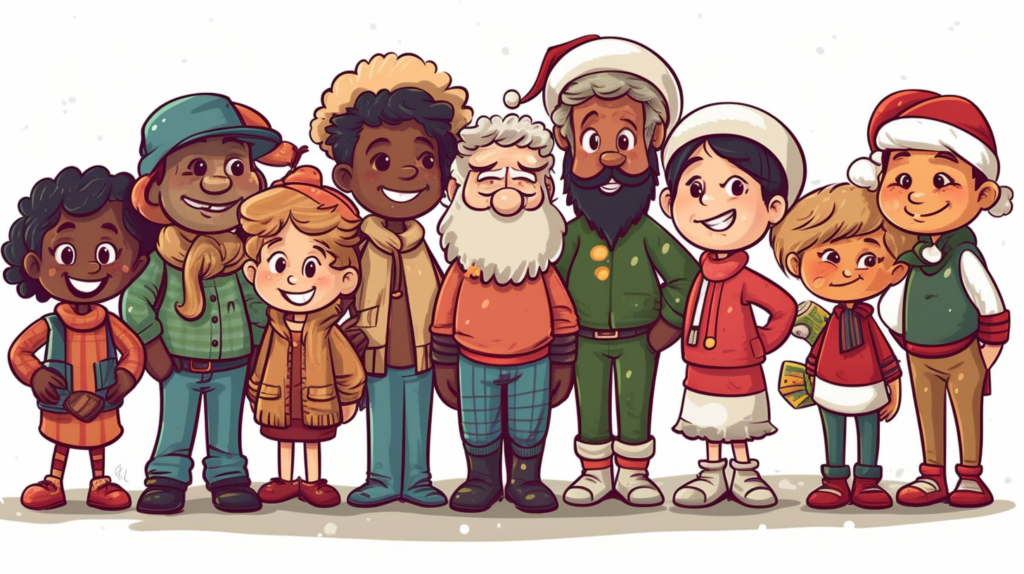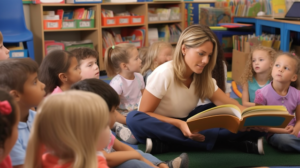Santa’s Passport: Exploring Christmas Around the Globe with Children
Introduction
Get ready for a magical journey as we embark on an enchanting adventure with Santa’s Passport! In this delightful exploration, children are invited to discover the rich tapestry of Christmas traditions from every corner of the globe. The holiday season is not just about twinkling lights and festive decorations; it’s a celebration of diverse cultures and unique customs that make each Christmas special.
Through Santa’s Passport, children are not only recipients of gifts but also global citizens gaining a deeper understanding of the world around them. This interactive experience encourages curiosity, fostering a sense of wonder and appreciation for the beautiful variety of ways people celebrate this joyous occasion.
Highlighting the Importance of Cultural Awareness
Santa’s Passport isn’t just a fun activity; it’s a tool for promoting cultural awareness and embracing differences. By learning about how different countries and communities celebrate Christmas, children develop a global perspective and a respect for diversity. This journey goes beyond the presents under the tree; it’s a gift of knowledge, fostering tolerance and understanding.
All Aboard, Next Stop

Australia: Celebrating a Summer Christmas
In Australia, Christmas unfolds against the backdrop of summer, creating a unique and vibrant celebration. Here are some distinctive traditions:
- Summer Holidays Kick Off: As Christmas aligns with the beginning of the summer holidays, Australians dive into the festive spirit during the warmer months, enjoying outdoor activities and relaxation.
- Carols by Candlelight: Australians gather for outdoor events like “Carols by Candlelight,” where communities come together to sing Christmas carols under the stars.
- Beach Celebrations: With the sun shining, many Australians head to the beach for festive picnics, barbecues, and water activities, making the most of the summer weather.
- Holiday Midday Dinner: Christmas Day features a significant midday dinner where families and friends unite to share a feast, often with a variety of seafood and traditional Christmas desserts.
- Lighting Up the Night: Given the longer daylight hours, Christmas light displays are a dazzling spectacle, illuminating neighborhoods and cities across the country.
South Africa: A Summer Festive Celebration
In South Africa, the Christmas season is embraced with a blend of traditional and unique customs:
- Classic Christmas Trees: Despite the summertime celebration, South Africans decorate Christmas trees, often opting for artificial trees or indigenous evergreens.
- Gift-Giving: Similar to many Western traditions, South Africans exchange gifts, symbolizing the spirit of giving and sharing joy with loved ones.
- Christmas Dinners: Families and friends come together for festive dinners, enjoying a mix of traditional Christmas dishes and local favorites.
- Outdoor Celebrations: The warm weather encourages outdoor gatherings, with many South Africans enjoying picnics, braais (barbecues), and outdoor festivities with loved ones.
- Religious Observances: Attendees participate in Christmas church services, reflecting on the religious significance of the holiday.

Colombia: Festive Traditions in the Heart of South America
Colombia celebrates Christmas with vibrant traditions that reflect the country’s rich cultural heritage:
- Novena Navideña: Colombians engage in Novena Navideña, a series of nine nightly gatherings leading up to Christmas. Families come together to pray, sing carols, and share festive foods.
- El Día de las Velitas: On December 7th, Colombians kick off the Christmas season by lighting candles and lanterns in honor of the Virgin Mary. This tradition, known as El Día de las Velitas, transforms streets into a sea of lights.
- Aguinaldos: Gift-giving is a cherished tradition called Aguinaldos. Small presents are exchanged between friends, family, and neighbors throughout the Christmas season.
- Feast of the Immaculate Conception: Celebrated on December 8th, this public holiday marks the official start of Christmas in Colombia. Festivities include parades, music, and street performances.
- Traditional Foods: Colombian Christmas tables feature special dishes like natilla (custard), buñuelos (fried dough balls), and hojuelas (deep-fried pastry).
Mexico: A Colorful Fiesta of Christmas Traditions
In Mexico, Christmas is a joyful fiesta filled with unique customs:
- Las Posadas: From December 16th to 24th, Mexicans celebrate Las Posadas, reenacting Mary and Joseph’s search for a place to stay. It involves processions, caroling, and breaking piñatas.
- Nochebuena: Christmas Eve, or Nochebuena, is a key celebration. Families gather for a festive feast, often featuring traditional dishes like bacalao (codfish) and ponche (fruit punch).
- La Misa de Gallo: Midnight Mass, or La Misa de Gallo, is attended by many Mexicans. After the mass, families return home for a late-night meal.
- Nacimiento: Elaborate nativity scenes, or Nacimiento, are a common decoration in Mexican homes. They often include not only the Holy Family but also various characters representing daily life.
- Piñatas: Colorful piñatas, filled with candies and fruits, are a popular element of Christmas celebrations, especially during Las Posadas.
Christmas foods from around the world? Look at These!
Italy: A Timeless Celebration in the Heart of Europe

Italy’s Christmas traditions are steeped in history and cultural significance:
- Presepe: Nativity scenes, or Presepe, are a cherished Italian tradition. Many families create intricate nativity scenes at home or visit elaborate displays in town squares.
- La Vigilia: Christmas Eve, known as La Vigilia, is marked by a festive seafood dinner. The Feast of the Seven Fishes is a common tradition, symbolizing the wait for the midnight birth of Jesus.
- Zampognari and Pifferai: Traditional musicians, Zampognari and Pifferai, play bagpipes and flutes in the streets, adding a charming musical element to the holiday atmosphere.
- Panettone and Pandoro: These sweet bread varieties, Panettone and Pandoro, are staples of Italian Christmas desserts, often shared with loved ones during festive gatherings.
- Befana: On the night of January 5th, the Befana, a kind old witch, delivers gifts to children, leaving them in stockings or shoes.
India: Diverse Celebrations Across the Subcontinent
Christmas in India is a festive occasion celebrated with a blend of religious and cultural traditions:
- Religious Diversity: With a rich tapestry of religions, Christmas is celebrated by Christians and non-Christians alike. It’s a time when communities come together to share the joy of the season.
- Midnight Mass: Attendees often participate in Midnight Mass on Christmas Eve, a solemn and joyous occasion in churches across the country.
- Decorations and Lights: Homes, streets, and churches are adorned with colorful decorations and lights, creating a vibrant and festive atmosphere.
- Gift-Giving: Exchanging gifts is a common practice during Christmas in India. Families and friends come together to share presents and good wishes.
- Traditional Sweets: Special Christmas sweets and treats are prepared, adding a delicious touch to the celebrations.
Iceland: Yuletide Magic in the Land of Fire and Ice
Icelandic Christmas traditions are rooted in folklore and enchanting customs:
- Yule Lads: Icelandic children are visited by the Yule Lads, mischievous characters who leave gifts or potatoes in shoes placed by the window. The Yule Lads are a unique and beloved part of Icelandic Christmas.
- Thirteen Days of Christmas: Icelanders celebrate Christmas for thirteen days, with various events and gatherings throughout the festive period.
- Christmas Eve Bonfires: On Christmas Eve, communities come together for bonfires, creating a warm and communal atmosphere amidst the winter cold.
- Book Flood Tradition: Icelanders have a charming tradition called “Jólabókaflóð,” or the Christmas Book Flood. It involves exchanging books on Christmas Eve and spending the night reading.
- Northern Lights: The natural spectacle of the Northern Lights adds a magical touch to the Icelandic Christmas experience.
Holland: Sinterklaas and Festive Delights
Dutch Christmas traditions are unique, with a focus on the beloved figure of Sinterklaas:
- Sinterklaas Arrival: The festive season kicks off with the arrival of Sinterklaas on December 5th. This event includes parades, music, and the distribution of treats.
- Gifts and Sweets: Similar to other European countries, Dutch children receive gifts in their shoes left by the fireplace. Sinterklaas is accompanied by his helpers, known as “Zwarte Pieten.”
- Feast of St. Nicholas: December 6th, known as the Feast of St. Nicholas, is a day of celebration with special foods and activities for families.
- Christmas Day and Boxing Day: While Sinterklaas is the primary figure for gift-giving, Christmas Day and Boxing Day are also observed with family gatherings and festive meals.
- Winter Atmosphere: Dutch cities and towns transform into winter wonderlands with Christmas markets, light displays, and seasonal decorations.

Importance of Cultural Education for Children: A Festive Journey of Learning
In the vibrant tapestry of childhood, cultural education shines as a beacon, guiding little minds through a world of diversity and celebration. Exposing children to global holiday traditions is akin to unlocking a treasure trove of educational delights.
- Joyful Learning Adventures: Introducing children to the kaleidoscope of global festivities transforms education into an exciting journey. From Diwali’s radiant lights to the cheerful melodies of Christmas carols, each tradition is a colorful chapter waiting to be explored.
- Cultural Empathy in Full Bloom: As children encounter diverse customs, they cultivate a garden of empathy. Learning about the rituals and celebrations of different cultures nurtures understanding, compassion, and an appreciation for the rich mosaic of humanity.
- Celebrating Unity in Diversity: The educational value extends beyond facts; it fosters a sense of unity in diversity. Children grasp that, despite different traditions, the essence of celebration—the joy, love, and togetherness—unites people worldwide.
- Building Open Minds and Hearts: Early exposure to cultural diversity builds foundations for open-mindedness. Children develop the capacity to embrace differences, challenging stereotypes and biases, fostering an inclusive worldview.
- Lifetime Lessons in Tolerance: The benefits of cultural education extend far into adulthood, shaping individuals with a foundation of tolerance. By sowing these seeds early, we cultivate a future generation that values and respects diversity.
This journey is an important one, where every celebration becomes a lesson, every tradition a story, and every child a global citizen in the making.
Santa’s Passport Activity: A Festive Journey of Learning
Bring the magic of Christmas traditions around the world to life with the interactive and creative “Santa’s Passport” activity. This engaging project allows children to explore diverse holiday customs, fostering cultural awareness and excitement.
Materials Needed:
- Passport Template: Print or create a passport template with blank spaces for stamps and information.
- Markers, Crayons, and Stickers: For decorating and personalizing passports.
- World Map or Globe: To visually represent the countries and their traditions.
- Stamps or Stickers Representing Countries: Create or use stamps and stickers that symbolize different countries.
Step-by-Step Guide:
1. Passport Creation
- Cover Design: Let children design their passport cover with festive drawings, stickers, and colors.
- Personal Information Page: Include a section for the child’s name, age, and a fun holiday-related question like “What’s your favorite Christmas tradition?”
- Country Pages: Dedicate pages for each country, leaving space for stamps, drawings, or notes.
2. Introduction to Christmas Traditions:
- Gather Around the Globe: Show the world map or globe, explaining that Santa is taking a special trip to learn about holiday traditions in different countries.
- Brief Descriptions: Share brief, child-friendly descriptions of customs in various countries.
3. Exploring Each Country:
- Passport Stamps: As you introduce each country, provide a stamp or sticker related to its Christmas traditions.
- Interactive Elements: Include interactive elements like drawing a holiday symbol or writing a fun fact on each country’s page.
4. Hands-On Activities:
- Crafts and Games: Integrate simple crafts or games related to each country’s traditions. For example, making paper lanterns for Diwali in India or playing a dreidel game for Hanukkah in Israel.
5. Cultural Exchange:
- Sharing Session: Encourage children to share their passports and discuss what they’ve learned.
- Sticker Swap: Allow kids to “swap” stickers or stamps with each other to mimic a cultural exchange.
6. Passport Completion and Certificate:
- Completion Stamp or Sticker: Once all countries are explored, give a completion stamp or sticker.
- Certificate of Cultural Explorer: Award each child a certificate for successfully exploring Christmas traditions around the world.
Santa’s Passport transforms learning into a festive adventure, promoting cultural understanding and creating cherished memories for children. Looking for more children’s free activities and crafts? Look here.

Conclusion: A Global Celebration of Joy and Learning
The journey of exploring Christmas traditions around the world with children is an enriching and joyous experience. Through this multicultural adventure, young minds embark on a delightful exploration of diverse customs, fostering a deeper understanding of global celebrations.
From discovering the magic of Diwali in India to the festive cheer of Hanukkah in Israel, each country’s unique traditions become colorful strokes in the canvas of cultural awareness. The interactive nature of activities, crafts, and stories engages children actively, making the learning process both educational and fun.
This global exploration not only widens the horizons of children but also instills values of empathy, respect, and acceptance. By celebrating the rich tapestry of holiday traditions, youngsters develop a profound appreciation for the diversity that makes our world so wonderfully unique.
As parents and educators, let us embrace and encourage these multicultural learning opportunities during the holiday season. By doing so, we not only impart valuable lessons but also create a nurturing environment that celebrates differences and cultivates a sense of unity. The festive season becomes a time not only for merry celebrations but also for the shared joy of understanding and respecting the cultural richness that surrounds us.
In this spirit of unity in diversity, let us continue to make every holiday season a global celebration of joy, learning, and the beauty of our interconnected world.


Ms. Kerri’s Corner provides a exciting virtual space for preschool learning. Through a variety of engaging activities, she exposes young minds to early math, literacy, science and social-emotional skills in a developmentally appropriate way. Centers for blocks, art, books and music allow children to explore hands-on learning at their own pace. Guided lessons subtly introduce number sense, letter sounds and narrative thinking. Careful observation gives insight into each child’s progress across domains. Viewers are also invited to participate, reinforcing that their ideas are valued. By making learning fun yet purposeful, Ms. Kerri lays the groundwork for future academic success while fostering creativity and imagination. Her program offers preschoolers valuable screen-based learning experiences.




